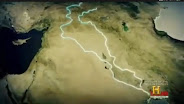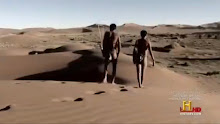Rather than die off from the ice age we have adapted and become even more intelligent - now we have colonized the entire globe. From coast to mountaintop from tundra to desert humans are there.
Our closest living ancestors chimpanzees live in the tropics, they only live in the tropics. Humans have managed to colonize the entire globe.
Ice age land bridges allowed man to spread around the world but now the ice begins to melt and sea levels rise again. Humans are trapped and separated in two vast and unconnected hemispheres. Each pocket of humanity left to make the best of what it has been given.
As the glaciers recede they carve out lakes rivers and bays. The map as we know it emerges.
With temperatures warming after the Ice Age plants and animals are more plentiful and man can finally choose to stop moving; permanent settlements begin populations grow.
With more mouths to feed our ancestors have to get clever, they had to find a way to increase the amount of food they could get from the surroundings. Now one discovery forever changes the planet and the path of mankind.
We learn to plant seeds and the seeds we sow come from the same plants that millions of years earlier spurred our evolution from ape to man. The unheralded hero of human history grass.
The grass seed is tiny right - it's no food - I can hunt a bison or I can take grass; I take a bison, right… Ironically grass seeds become the most important food crops in the world but they're the things that are ignored by hunter-gatherers for thousands and thousands of years. People don't start using it until they absolutely have to use them.
Some of the species of grass that we are most familiar with includes sugar cane. It includes wheat and rye and barley. All of the cereal crops are types of grass, so it's not just that beautiful green lawn that we measure our middle-class success from, it's also the staple crop upon which civilization depends. It is the majority of our calorie intake.
Once again it all goes back to the Big Bang. Central to the story of all life is our competition for that energy created at the beginning of time. Just as oxygen gave us an edge - just as fire allowed us to consume more calories - switching to farming is an energy revolution.
A hunter-gatherer needs 10 square miles of territory to provide himself with enough sustenance, enough energy, in the form of plants and meat to survive.
A farmer can harvest the sun's energy so efficiently he can fulfill his needs using only 1/10 of a square mile of land
In the warming after the last ice age farming begins to take hold in a half-dozen places around the globe but by the fortunes of geography no place in the ancient world has a better concentration of plants and animals that can be domesticated than the Middle East's Fertile Crescent.
In the Middle East we have this remarkable convergence of species that seemed to have been susceptible to domestication - both plants and animals.
- In terms of animals we're talking about; cattle, pigs, sheep and goats
- in terms of plants; two varieties of wheat, rye, barley, lentils, figs…
all in this very small part of the world.
Unlike the Fertile Crescent and the rest of afro-eurasia, places like sub-saharan Africa and the Americas have very few wild species that can be easily domesticated. It's a critical difference - people blessed with the right mix of plants and animals will become more powerful and get a massive head start on the road to the modern world.
River Valley Civilization - Wikipedia
https://en.wikipedia.org/wiki/River_valley_civilization
Hydraulic Empire - Wikipedia
https://en.wikipedia.org/wiki/Hydraulic_empire
Megafloods of the Ice Age | NOVA | PBS
https://www.pbs.org/wgbh/nova/article/megafloods-of-the-ice-age/
The First Civilizations
The first civilizations formed on the banks of rivers.
The most notable examples are the Ancient Egyptians, who were based on the Nile, the Mesopotamians in the Fertile Crescent on the Tigris Euphrates rivers, the Ancient Chinese on the Yellow River, and the Ancient India on the Indus. These early civilizations began to form around the time of the Neolithic Revolution (12000 BCE).Hydraulic Empires
Though each civilization was uniquely different, we can see common patterns amongst these first civilizations since they were all based around rivers. Most notably, these early civilizations were all hydraulic empires. A hydraulic empire (also known as hydraulic despotism, or water monopoly empire) is a social or governmental structure which maintains power through exclusive control over water access.
This system of government arises through the need for flood control and irrigation, which requires central coordination and a specialized bureaucracy.
This political structure is commonly characterized by a system of hierarchy and control based around class or caste. Power, both over resources (food, water, energy) and a means of enforcement, such as the military, are vital for the maintenance of control.
Most hydraulic empires exist in desert regions, but imperial China also had some such characteristics, due to the exacting needs of rice cultivation.
The only hydraulic empire to exist in Africa was under the Ajuran State near the Jubba and Shebelle Rivers in the 15th century CE.Karl August Wittfogel, the German scholar who first developed the notion of the hydraulic empire, argued in his book, Oriental Despotism (1957), that strong government control characterized these civilizations because a particular resource (in this case, river water) was both a central part of economic processes and environmentally limited. This fact made controlling supply and demand easier and allowed the establishment of a more complete monopoly, and also prevented the use of alternative resources to compensate.
However, it is also important to note that complex irrigation projects predated states in Madagascar, Mexico, China and Mesopotamia, and thus it cannot be said that a key, limited economic resource necessarily mandates a strong centralized bureaucracy.
According to Wittfogel, the typical hydraulic empire government has no trace of an independent aristocracy—in contrast to the decentralized feudalism of medieval Europe.
Though tribal societies had structures that were usually personal in nature, exercised by a patriarch over a tribal group related by various degrees of kinship, hydraulic hierarchies gave rise to the established permanent institution of impersonal government. Popular revolution in such a state was very difficult; a dynasty might die out or be overthrown by force, but the new regime would differ very little from the old one. Hydraulic empires were usually destroyed by foreign conquerors.
Water Scarcity Today
Access to water is still crucial to modern civilizations; water scarcity affects more than 2.8 billion people globally. Water stress is the term used to describe difficulty in finding fresh water or the depletion of available water sources. Water shortage is the term used when water is less available due to climate change, pollution, or overuse.
Water crisis is the term used when there is not enough fresh, clean water to meet local demand. Water scarcity may be physical, meaning there are inadequate water resources available in a region, or economic, meaning governments are not managing available resources properly. The United Nations Development Programme has found that water scarcity generally results from the latter issue.
River Valley Civilizations | World Civilization
https://courses.lumenlearning.com/suny-hccc-worldcivilization/chapter/river-valley-civilizations/






















